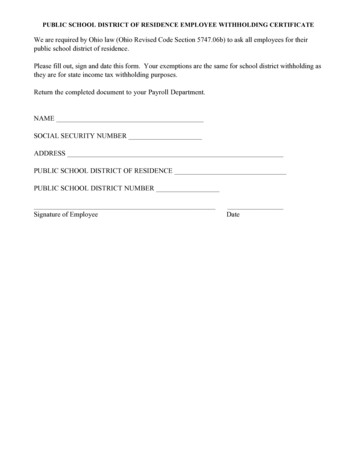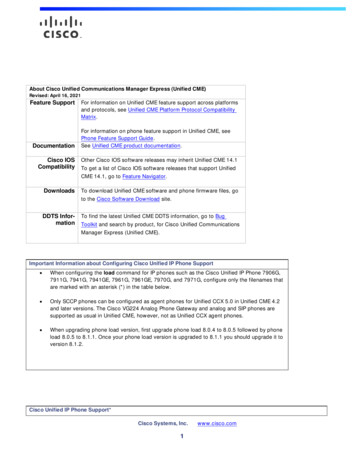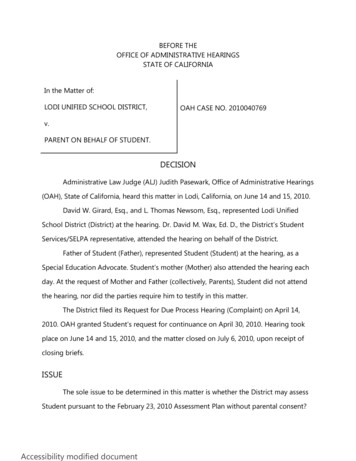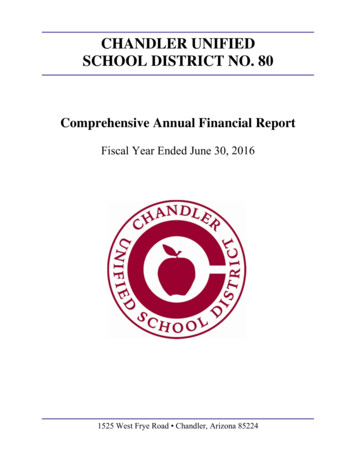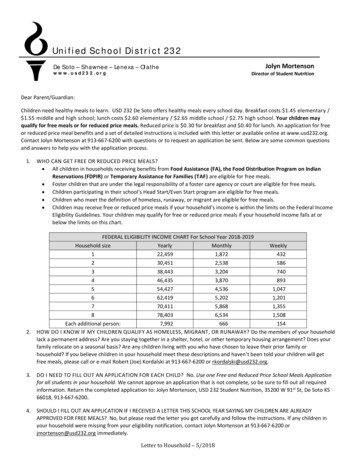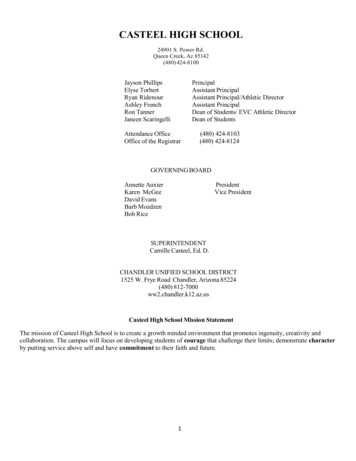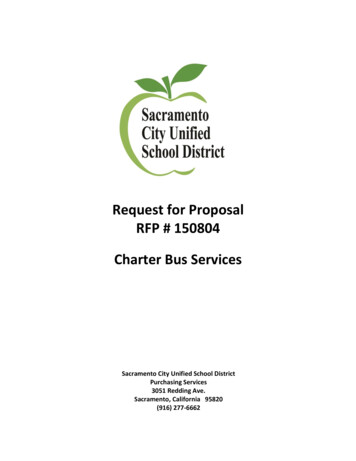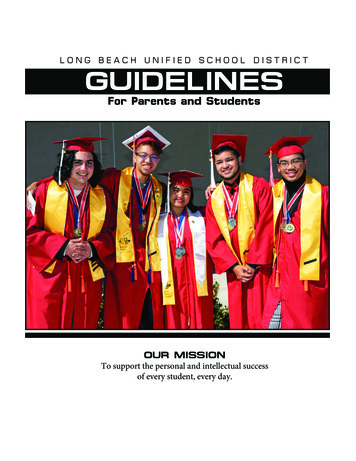
Transcription
Burbank Unified School DistrictA Look AtCollege RequirementsFor Middle School ParentsAnd StudentsDavid Starr Jordan Middle SchoolLuther Burbank Middle SchoolJohn Muir Middle School
High School Graduation and Minimum 4-Year College Eligibility RequirementsBUSDGraduation RequirementsCalifornia State University (CSU)Minimum Eligibility “a-g” RequirementsUniversity of California (UC)Minimum Eligibility “a-g” RequirementsSocial StudiesWorld History or European History (10Credits)U.S. History (10 Credits)Government (5 Credits)Economics (5 Credits)EnglishEnglish 9 (10 Credits)English 10 (10 Credits)English 11 (10 Credits)English 12 (10 Credits)a. Social Science (2 years)World HistoryUS History(may use American Government for ½year of U.S. History)a. Social Science (2 years)World HistoryUS History(may use American Government for ½year of U.S. History)b. English (4 years)(college prep)b. English (4 years)(college prep)Mathematics (20 Credits)Students must pass Algebra I as well ascomplete 20 credits.c. Mathematics (3 years)c. Mathematics (3 years)(4 years recommended)Algebra IGeometryAlgebra IIScience (20 Credits)d. Laboratory Science (2 years)Physical ScienceBiologyPhysical ScienceBiological SciencePractical Art (10 credits)(Requirement waived if three years ofsame foreign language are completed)Fine Arts (10 Credits)Physical Education (20 Credits)(Must pass Fitness Test)e. Language Other Than English (2years)e. Language Other Than English (2years)(3 years recommended)f. Visual and Performing Arts (1 year)One yearlong course in dance,drama/theatre, music, or visual artf. Visual and Performing Arts (1 year)One yearlong course in dance,drama/theatre, music, or visual artElectives (70 Credits)g. College Preparatory Electives (1 year)One additional year in any of the aboveA-F areas or other approved electiveg. College Preparatory Electives (1 year)One additional year in any of the aboveA-F areas or other approved electiveTotal 230 CreditsSAT or ACT must be completed byDecember of Senior yearSAT or ACT must be completed byDecember of Senior yearGrades of “D” are unacceptable foradmission in most subjectsSubject Tests are not required andstudents must finish 11 of the 15 a-grequirements by the end of junior yearAlgebra IGeometryAlgebra IId. Laboratory Science (2 years)(3 years recommended)Requires classes in at least two of thefollowing areas: biology, chemistry, andphysicsHealth/Careers (10 Credits)10 hours of Service LearningGrades of “D” are unacceptable foradmission in most subjects
High School Graduation Course RequirementsThe Burbank Unified School District requires 230 units for high school graduation, with certainclasses required for all students, and elective courses to be chosen from student interest andcourse ssesEnglish 9, English 10,English 11, English 12Any two, year-long classes for which the student meets theprerequisites. All 9th and 10th grade students must enroll in amath class.All students must pass Algebra Ior its equivalent in order toreceive a diploma.ScienceHealth/CareersSocial Studies201010105Physical Education520Fine ArtsPractical Arts/CTE1010Electives70Total Units230One year of physical science required(physical science, geo-science, chemistry, or physics).One year of life science required(biology, life science, anatomy/physiology).Required of all 9th grade students (1 year)10th grade World History (1 year)11th grade U.S. History (1 year)Economics (1 semester) or Economics & the World ofFinance (1 semester)Government – American Government (1 semester)Any two, year-long classes, or four one-semester classes,including athletics. 9th and 10th grade students are required totake physical education. SB 78, effective July 1, 2007,mandates that students must pass the Physical Fitness Test in9th grade or 10th grade P.E. in order to receive an exemptionfor 11th grade and 12th grade P.E. If this mandate is not met in9th grade or 10th grade P.E., the student must take a P.E. classin the 11th grade and 12th grade and take the Physical FitnessTest until the student has passed this test. (E.C. 51241)Any year-long classAny year-long or two one-semester classes, including anyROP classAny classes, with the exception of those designated asrequired for graduation credits.In addition to credit requirements:Service Learning – 10 hoursPassing Score on the California High School ExitExamination2
POST-SECONDARY EDUCATIONAL OPTIONSSuccess in high school is still the best predictor for success in college. Students may ensure theirsuccess by obtaining a solid educational background. It is recommended that students inquireabout Honors and Advanced Placement sections in the courses they plan to take and that theyinclude as many courses in English, mathematics, science, social studies, and foreign language aspossible. Students should be aware of and take the courses listed on page 9 in consideringattendance at a four-year college. Taking the PSAT, SAT, and ACT and attending collegeinformation meetings during the junior year is strongly encouraged.When thinking about college, students should consider all their options. There are manyindependent colleges and career technical schools, as well as the extensive offerings inCalifornia’s higher education system. The State of California maintains three different collegesystems. Each of these has its own entrance requirements. For private or out-of-state colleges,students should consult the catalog section in the Career Center at their school. In the spring ofthe junior year, students should consult counselors regarding admissions procedures.Independent CollegesThere are hundreds of independent colleges and universities around the country with a widerange of characteristics that make them attractive to students. Since the tuition is paid by thestudent rather than by public tax dollars, the cost to the family may be greater than the cost in apublic university. Financial aid is often available based upon need.While some independent colleges are in the most competitive category for admission, others arelooking for students in the top half of their graduating classes. In addition to the typicaladmission requirements of subjects, grades, and test scores, the independent colleges often take acloser look at individual students by requiring letters of recommendation and, sometimes,personal interviews. Most college prep students will meet the admission criteria of one or morecampuses.There are great differences in size, educational purpose, and emphasis among these institutions.Some are small and offer students a personalized campus. Some campuses may have a particularvocation or religious emphasis. There are 70 private colleges with over 125 possible majorsavailable in California. Specific information about the requirements and educationalopportunities available at any independent college in the United States may be obtained throughthe high school Career Center or directly from the institution.Career Technical SchoolsStudents whose interests and talents center around school workshops, labs, and work experiencemay benefit most by short-term, highly specialized training. Such training is available throughthe Career and Technical Education (CTE) program, community colleges, proprietary schools,and hospital schools. Students should talk with their counselors and teachers in their area ofinterest to investigate programs available to them.3
California Community CollegesThere are 105 community colleges in California, where students can complete the freshman andsophomore years of a university education. Community colleges also offer programs varying inlength from one semester to two years, which prepare students for occupations and positions thatdo not require a university degree.ELIGIBILITY Open to all high school graduates or those who pass the California High School ProficiencyExamination.Open to any adult of at least age 18 who can benefit from the instruction.PROGRAMSThere are three main programs, offered by California Community Colleges:1. The Transfer Program is intended for students who want to complete the first two years ofcollege before transferring to a four-year college. While in high school, these students shouldselect and meet entrance requirements for a four-year college before entering the communitycollege. More California State University students complete their first two years at a communitycollege than complete those years at the university.2. The Certificate Program is intended for students who wish specific training in a careerfield. Since not all courses are offered at any single college, students should contact thecommunity college of their choice to see if their desired career program is offered. A studentcompleting the career course requirements will be granted a Certificate of Achievement.California Community College Career ProgramsAgricultureBusiness and FinancialCommunicationsCriminal JusticeElectrical-ElectronicsEngineering TechnologyEnvironmental and NaturalSciencesHuman ServicesHome Economics and FoodServicesMid-Management andSupervisionScience and LaboratoryOccupationsService OccupationsTrade and Industry3. The Associate of Arts Degree Program is intended for students who want to end theirhigher education after the first two years of college. When students start classes at a communitycollege, they should familiarize themselves with requirements so the classes they take will lead tothe AA Degree. These courses will require a college prep background in high school.4
California State University (CSU) SystemThere are twenty-three (23) campuses in the California State University system spanning the stateof California, with an enrollment exceeding 325,000 students and offering more than 1,600degree programs. The CSU campuses are: Bakersfield, Channel Islands, Chico, DominguezHills, East Bay, Fresno, Fullerton, Humboldt, Long Beach, Los Angeles, Maritime Academy,Monterey Bay, Northridge, Cal Poly Pomona, Sacramento, San Bernardino, San Diego, SanFrancisco, San Jose, Cal Poly San Luis Obispo, San Marcos, Sonoma, and Stanislaus. The StateUniversity System has entrance requirements designed to admit thirty-three percent (33%) ofCalifornia high school graduates. Eligibility for entrance depends upon the GPA combined witha score on either the SAT or the ACT admission tests. The rule of thumb is that the higher theGPA, the lower the test score required, and conversely, the lower the GPA, the higher the testscore required. October 1st – November 30th of the senior year is the initial application-filingperiod for the following fall.The University of California (UC) and California State University (CSU) have agreed to adoptthe same pattern of academic courses required for freshman eligibility, enabling high schoolstudents to take the same courses to prepare for admission to both institutions. CSU trusteesvoted to reduce by two the number of elective courses they now require, and to replace themwith an additional year of laboratory science and an additional year of history/social science.The minimum requirements for both systems are: four years of English, three years ofmathematics, two years of history/social science, two years of laboratory science, two years oflanguage other than English, one year of visual or performing arts and one year of electives. Agrade of “C” or higher is required in each course.For courses meeting the CSU requirements, refer to the list on page 6-7.Examination Requirement: All students must submit scores from either SAT, SAT Subjecttests or ACT.Grade Requirement: Overall GPA for grades 10-12 (excluding PE) is combined with SAT orACT scores to determine admission qualifications. All courses taken to meet the requirementsmust be completed with a grade of “C” or higher. Details on calculating GPA, including the useof Honors or Advanced Placement course grades, are available from counselors. Incomingfreshmen must have an eligibility index which places them among the upper one-third ofCalifornia high school graduates.University of California (UC)There are ten campuses in the UC system: Berkeley, Davis, Merced, San Francisco, Santa Cruz,Santa Barbara, Los Angeles, Irvine, Riverside, and San Diego. To be eligible for admission,students must satisfy all requirements listed below. The UC System admits only the top oneeighth, or twelve and a half percent (12.5%), of all high school graduates. November 1-30 of thesenior year is the initial application filing period for the following fall.5
Grade Requirement:All courses taken to meet the entrance requirements must be completed with a minimum grade of“C” or higher. Details on calculating grade point averages, including the use of Honors orAdvanced Placement course grades are available from counselors. A combination of GPA andSAT or ACT test scores is the primary basis for admission to the University of California system;however, the personal statement and extracurricular activities are also important components ofthe application.Minimum Course Requirements:All courses intended to meet UC requirements must be designated college preparatory. (Seepages 6-7 for a list of these courses, by department.)Two years History/Social ScienceFour years EnglishThree years college prep Math required, with four years recommendedTwo years Lab Science* required, three or more years recommendedTwo years Foreign Language, three or four years recommendedOne year of Visual or Performing ArtsOne year of university-approved electives selected from at least two areas:4th year Advanced Math; 3rd, 4th, or 5th year Foreign Language, additionalyear(s) of Lab Science, Social Science, Visual/Performing Arts (limited)* One year of lab science may be completed in ninth grade. Biology and Chemistry or Physicsrequired.Selectivity:Because several UC campuses have more applicants than they can accommodate, they emphasizethe breadth (range of course work taken) and depth (number of years taken, Honors and APcourses) when making admission decisions.Examination Requirement:All students must submit scores from either SAT or ACT. In addition, all students are stronglyrecommended to submit scores from SAT subject tests and are urged to check with the college oruniversity to which s/he is applying.Testing must be completed by December of the senior year for all applications.College Preparatory Subjects (courses satisfy the UC “a-g” and CSU subject requirements):a. History--2 yearsGovernment, Transitional Government, AP Government, Honors Government, Mock TrialAP European History, United States History, SDAIE U.S. History, AP U.S. History, WorldHistory, SDAIE World History, AP World Historyb. English--4 yearsEnglish 9-12, Transitional English 9-12, Honors English 9-10Honors English 11, AP English LiteratureAdvanced ELD 3,4 (maximum 1 unit with other ESL-type English courses)6
College Prep Englishc. Mathematics--3 years, 4 years recommended (*may only be used for the “c”requirement)*Algebra, *Geometry, *Algebra 2, *Trigonometry, Pre-Calculus,*SDAIE Algebra, *SDAIE Geometry, *SDAIE Algebra 2,AP Calculus AB, AP Calculus BC, AP Statisticsd. Laboratory Science--2 years required, 3 recommendedAnatomy and PhysiologyBiology, SDAIE Biology, AP Biology, Honors Biology, Chemistry, Geo-Science, HonorsChemistry, SDAIE Chemistry, AP Chemistry, Physics, AP Physics, Micro/Marine Biologye. Foreign Language--2 years required, 3 recommendedFrench 1-3, AP French 4Spanish 1-3, AP Spanish Language 4, AP Spanish Literature 5Spanish for Spanish Speakers 1-2American Sign Language 1-3f. Visual/Performing Arts—1 year requiredAdvanced Art, Advanced Art/Portfolio, Advanced Photography, AP Studio Art, Art History,Music Appreciation, Band, Jazz Ensemble, Field Performance, Orchestra, Wind Ensemble,Chamber Choir, Madrigal Choir, Mixed Choir, Musical Production, Musical Theater, APMusic Theory, Photography 1, Photography 2, Animation, Art Structure 1, Art Structure 2,Sculpture 1, Dance 1, Digital Art and Video Production, Drama 1, Dance Production.Play Production (For updated list of UC approved courses, see your counselor orwww.ucop.edu/doorways)g. Elective Courses (all courses listed under a-e with the exception of *math courses plus thefollowing):History -- all courses listed under “a”English -- Journalism, Speech, DebateAdvanced Mathematics -- AP Computer Science A, AP Computer Science AB, Pre-Calculus,Calculus, Statistics, Computer ScienceLaboratory Science--all courses listed under “d”Foreign Language--all courses listed under “e” (with the exception of first year language)Social Science--Economics, SDAIE Economics, Honors Economics, AP Economics,Psychology, SociologySports Medicine (ROP)Note: Only underlined courses will be assigned extra honors credit: A 5, B 4, C 3For complete listing of UC approved courses, see www.ucop.edu/doorways7
What to Consider When Choosing a College:Geography: Type of locationIn addition to the importance of academics playing a role in determining theright school for you, where a campus is located might also be important. Where doyou want to study? Is year-round sunshine a must for your mental health, or doesthe call of the winter ski season require a more diverse climate? Perhaps you hopeto compose essays in the shadow of the Eiffel Tower, or maybe you prefer thecomforts of home. College is both an education and a journey, so consider whattype of location you hope to experience when exploring college information.SettingYou should also consider the ambience of your surroundings when choosing acollege. If you can't live without nightlife, think city! If you're into the greatoutdoors, you might want to go rural. There are colleges in every environment youcan imagine, from tiny towns in Minnesota to the middle of Manhattan.If you've always lived in the suburbs, an urban campus can be an adventure. Butafter a few weeks, will you yearn for grassy fields and open space? On the otherhand, if you're used to malls and movie theaters and choose a college in a ruralarea, will you be racing into the student center at midnight, desperately seekingnoise, lights, and people? When examining the options in a college guide, thinkabout where you grew up and how much of a change you want.Campus SizeDon't forget to consider the sizes of the schools in your college search. Collegescome in all sizes, from a school in California that enrolls only 26 students to auniversity like Penn State that can enroll 30,000 or more. Which one is better?That depends on you. Did you go to a small high school or a large one? Did you grow up in a city or a rural area? Do you like being places where everybody knows you, or do you like theanonymity of a crowd?Large schools typically have large campuses, as well as a healthy selection ofstudent services and things to do; a small college may offer individualizedattention, as well as a more intimate and personalized experience. You might evenwant to think about how far you want to walk to get from one class to another.Even those little details of college info may affect your decision.8
TypeThe different types of schools on your list can often be overlooked when you'reconsidering college criteria, but you should keep in mind that all colleges anduniversities are not the same. What do they devote time and resources to: research or teaching andlearning? Do they have a specialty in one specific area or are they known for providinga broad education? Are they single sex or coed? Do they have a religious affiliation? Are they public or private?There are also historically Black colleges, Hispanic-serving institutions, schoolswith co-op programs, and many with large evening and part-time programs. Acollege guide typically provides important facts about each school's type andcharacteristics. Your options are almost limitless and your personal learning style,preferences, and available resources will help you find the place where you'll bestsucceed.Cost, Scholarships, and Financial AidThe cost of college is one thing that most parents think about during the collegesearch process. Not all colleges and universities have the same price tag and thereare a variety of ways to cut your costs. Most schools offer financial aid,scholarships, and work-study programs, aside from student loans.Consider your special talents outside of the classroom. You may qualify for a fullride if you can carry a tune or a football (or both), while making the grade. Even ifyou don't get a full ride, every little bit helps.Public universities often offer much lower tuition rates to in-state students, buttheir fees to out-of-state residents are usually similar to private schools. Privateinstitutions charge everyone the same tuition, but they often have privatelyfunded scholarships, so it's worth applying even if the price tag seems too high.A school's tuition isn't necessarily the exact amount you'll pay, because it doesn'treflect financial aid or extra expenses like housing and books. But it's still wise tocheck out tuition figures when considering college information, as it may expand ordiminish your options, depending on your financial situation.9
10
College and Career ExplorationCalifornia’s Public Colleges and UniversitiesUniversity of California (UC): www.ucop.edu/pathwaysCalifornia State University (CSU): www.csumentor.eduCampus Locations: mmunity Colleges (CC): www.cccco.eduwww.cacareerzone.orgCareer Exploration, Career Personality,Monetary eer Explorationwww.calcareercenter.orgCareer Explorationhttp://www.bridges.comCollege/career planning tool for BUSDstudents through 12th gr.(Create a portfolio, use Site ID: 0105688 Password: dastarr; use your School ID# tocreate your .aspxVirtual college toursApp to scholarshipsMovmiento EstudiantilChincano de Aztlan
Social Studies 10 10th grade World History (1 year) 10 11th grade U.S. History (1 year) 5 Economics (1 semester) or Economics & the World of Finance (1 semester) 5 Government – American Government (1 semester) Physical Education 20 Any two, year-long cl

